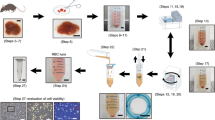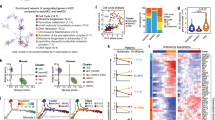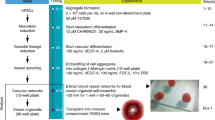Abstract
Herein, we describe a protocol for the isolation of human embryonic stem cells (hESCs)-derived vascular cells at various stages of development. The cells are isolated from 10 to 15-d-old human embryoid bodies (EBs) cultured in suspension. After dissociation, cells are labeled with anti-CD34 or anti-CD31 (PECAM1) antibody and separated from the cell mixture by magnetic-activated cell separation (MACS) or fluorescent-activated cell sorting (FACS). Isolated vascular cells are then cultured in media conditions that support specific differentiation and expansion pathways. The resulting vascular cell populations contain >80% endothelial-like or smooth muscle-like cells. Assuming typical initial cell adhesion and proliferation rates, the entire procedure can be completed within 1.5 months. Vascular cells isolated and differentiated under the described conditions may constitute a potential cell source for therapeutic application toward repair of ischemic tissues, preparation of tissue-engineered vascular grafts and design of cellular kits for drug screening applications.
This is a preview of subscription content, access via your institution
Access options
Subscribe to this journal
Receive 12 print issues and online access
$259.00 per year
only $21.58 per issue
Buy this article
- Purchase on Springer Link
- Instant access to full article PDF
Prices may be subject to local taxes which are calculated during checkout



Similar content being viewed by others
References
Ferreira, L.S. et al. Vascular progenitor cells isolated from human embryonic stem cells give rise to endothelial and smooth muscle like cells and form vascular networks in vivo. Circ. Res. 101, 286–294 (2007).
Levenberg, S., Golub, J.S., Amit, M., Itskovitz-Eldor, J. & Langer, R. Endothelial cells derived from human embryonic stem cells. Proc. Natl. Acad. Sci. USA 99, 4391–4396 (2002).
Levenberg, S. Engineering blood vessels from stem cells: recent advances and applications. Curr. Opin. Biotechnol. 16, 516–523 (2005).
Levenberg, S. et al. Differentiation of human embryonic stem cells on three-dimensional polymer scaffolds. Proc. Natl. Acad. Sci. USA 100, 12741–12746 (2003).
Levenberg, S. et al. Engineering vascularized skeletal muscle tissue. Nat. Biotechnol. 23, 879–884 (2005).
Levenberg, S., Zoldan, J., Basevitch, Y. & Langer, R. Endothelial potential of human embryonic stem cells. Blood 110, 806–814 (2007).
Carmeliet, P. & Jain, R.K. Angiogenesis in cancer and other diseases. Nature 407, 249–257 (2000).
Ferreira, L.S. et al. Bioactive hydrogel scaffolds for controllable vascular differentiation of human embryonic stem cells. Biomaterials 28, 2706–2717 (2007).
Coultas, L., Chawengsaksophak, K. & Rossant, J. Endothelial cells and VEGF in vascular development. Nature 438, 937–945 (2005).
Lammert, E., Cleaver, O. & Melton, D. Induction of pancreatic differentiation by signals from blood vessels. Science 294, 564–567 (2001).
Shen, Q. et al. Endothelial cells stimulate self-renewal and expand neurogenesis of neural stem cells. Science 304, 1338–1340 (2004).
Pouton, C.W. & Haynes, J.M. Embryonic stem cells as a source of models for drug discovery. Nat. Rev. Drug Discov. 6, 605–616 (2007).
Sartipy, P., Bjorquist, P., Strehl, R. & Hyllner, J. The application of human embryonic stem cell technologies to drug discovery. Drug Discov. Today 12, 688–699 (2007).
Bai, H. & Wang, Z.Z. Directing human embryonic stem cells to generate vascular progenitor cells. Gene Ther. 15, 89–95 (2008).
Vodyanik, M.A., Bork, J.A. & Thomson, J.A. Slukvin, II human embryonic stem cell-derived CD34+ cells: efficient production in the coculture with OP9 stromal cells and analysis of lymphohematopoietic potential. Blood 105, 617–626 (2005).
Wang, Z.Z. et al. Endothelial cells derived from human embryonic stem cells form durable blood vessels in vivo. Nat. Biotechnol. 25, 317–318 (2007).
Lerou, P.H. et al. Derivation and maintenance of human embryonic stem cells from poor-quality in vitro fertilization embryos. Nat. Protoc. 3, 923–933 (2008).
Braam, S.R. et al. Feeder-free culture of human embryonic stem cells in conditioned medium for efficient genetic modification. Nat. Protoc. 3, 1435–1443 (2008).
A, E.M. Isolation and propagation of mouse embryonic fibroblasts and preparation of mouse embryonic feeder layer cells. Curr. Protoc. Stem Cell Biol. Chapter 1 (2007).
Mooney, D.J. et al. Long-term engraftment of hepatocytes transplanted on biodegradable polymer sponges. J. Biomed. Mater. Res. 37, 413–420 (1997).
Acknowledgements
We would like to acknowledge the financial support of NIH grants HL060435 and DE013023 (R.L.), Marie-Curie Reintegration Grants (S.L. and L.S.F.), MIT-Portugal program (L.S.F.), Crioestaminal/Associação Viver a Ciência (L.S.F.) and FCT (PTDC/SAU-BEB/098468/2008) (L.S.F.). TPK was supported by the Swiss National Science Foundation (grant number PBELP3-127902).
Author information
Authors and Affiliations
Contributions
All authors wrote this paper.
Corresponding author
Ethics declarations
Competing interests
The authors declare no competing financial interests.
Rights and permissions
About this article
Cite this article
Levenberg, S., Ferreira, L., Chen-Konak, L. et al. Isolation, differentiation and characterization of vascular cells derived from human embryonic stem cells. Nat Protoc 5, 1115–1126 (2010). https://doi.org/10.1038/nprot.2010.31
Published:
Issue Date:
DOI: https://doi.org/10.1038/nprot.2010.31
This article is cited by
-
Role of TGFβ1 and WNT6 in FGF2 and BMP4-driven endothelial differentiation of murine embryonic stem cells
Angiogenesis (2022)
-
Vascular and blood-brain barrier-related changes underlie stress responses and resilience in female mice and depression in human tissue
Nature Communications (2022)
-
Strategies for derivation of endothelial lineages from human stem cells
Stem Cell Research & Therapy (2019)
-
An in vitro method to keep human aortic tissue sections functionally and structurally intact
Scientific Reports (2018)
-
Generation of Human Pluripotent Stem Cell-derived Endothelial Cells and Their Therapeutic Utility
Current Cardiology Reports (2018)
Comments
By submitting a comment you agree to abide by our Terms and Community Guidelines. If you find something abusive or that does not comply with our terms or guidelines please flag it as inappropriate.



